There is a quote from David Alan Harvey that says, “don’t shoot what it looks like, shoot what it feels like”, which has always resonated with me for a variety of reasons. For us as photographers, and as people, to get out of our head and instead in to our heart in whatever we do, it makes the experience more meaningful to us as well as those who might view what we do. A simple analogy might be a musician or singer….I’m sure have you heard one that plays the notes in perfect time, pitch perfect and executes the song wonderfully, albeit robotically and without feeling. Then, you have probably heard someone who puts their passion and soul in to a musical piece, singing from the heart in a way that comes through in the notes sung, notes that invariably draw you deeper in to the music and feel more of a connection with the piece. Shooting what it “looks like” is similar to someone just playing the notes as its written on the sheet music and shooting what it “feels like” is synonymous with someone singing from the heart and soul; you can feel the difference as you hear the music.
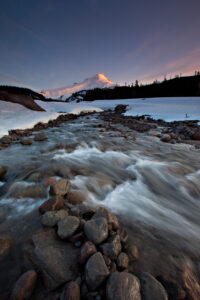
I feel the same is true with photography or visual arts that if we bring more of our passion and heart in to a piece, that will be translated to those who view our work and may connect with them on a deeper level. Photography is often dominated by discussions of technical specifications, focal lengths and “must visit” locations, yet very little is talked about passion, feelings, emotion or visual perception, probably because these are challenging topics to define and talk about and they are wildly different across each person, so one size doesn’t fit all. So, how does one shoot what it feels like? I’ll share a bit about my thought processes to capture emotion in a scene, to capture what it feels like to be standing in that exact location on that day, just know that for you, it may be a bit different to get in to that zone.
Slow Down and Connect
The first thing to do when you roll up on a shooting location is to SLOW DOWN and CONNECT. We are all typically excited to jump out of the car and start running around looking for compositions; I’ve done it and I’ve seen my workshop folks do it repeatedly. However, if we’re running around like chickens with our heads cut off, pumped up on excitement to photograph this location or use a new piece of gear, we may be missing many of the best compositions. In our excitement, we can only see the most obvious compositions because we’re hopped up and ready to shoot. Unfortunately the subtle and deeper compositions cannot cut through the fog of our excitement. So, the first thing you need to do at a location is to slow down! Yes you can and should notice the obvious compositions, yet also take time to walk around, notice the small details at the location, explore different angles on subjects, notice how changing light might illuminate a subject differently. And keep in mind, you’re doing this all with your camera still in your camera bag! If you don’t slow down, you’ll never be able to connect to your surroundings, which will lead you to shoot the obvious and shoot what it looks like, not what it feels like.
Connecting with your surroundings is only possible by slowing down, letting the excitement and adrenaline subside, and then taking a deeper look at compositional possibilities around you, connecting with the landscape on a deeper, more subtle level. You may notice how the shoreline curves, or how a pile of rocks is arranged pointing at the subject, or the texture in tree bark…whatever it may be, it’s this deeper connection that will allow you to tap in to the “feelings” of being in that location at that time. I’ve often said to my clients that when possible, I try to let my surroundings tell me what should be photographed. HA! Yes, it’s a little bit out there, but when you achieve a deeper connection with your surroundings, you will find that you may gravitate to certain areas or scenes, or emotions that are coming up in you. This is what I mean by letting the landscape tell me what to shoot, I follow my heart and listen to where its being pulled, to drive what I photograph. If I’m at an iconic location or at one with an obvious subject, yes I’ll shoot the postcard shot and get that out of the way. Then, I’ll let my heart guide what I shoot and often times these are the images that I treasure most as they feel like I capture more of “soul” of the area, not just a postcard.
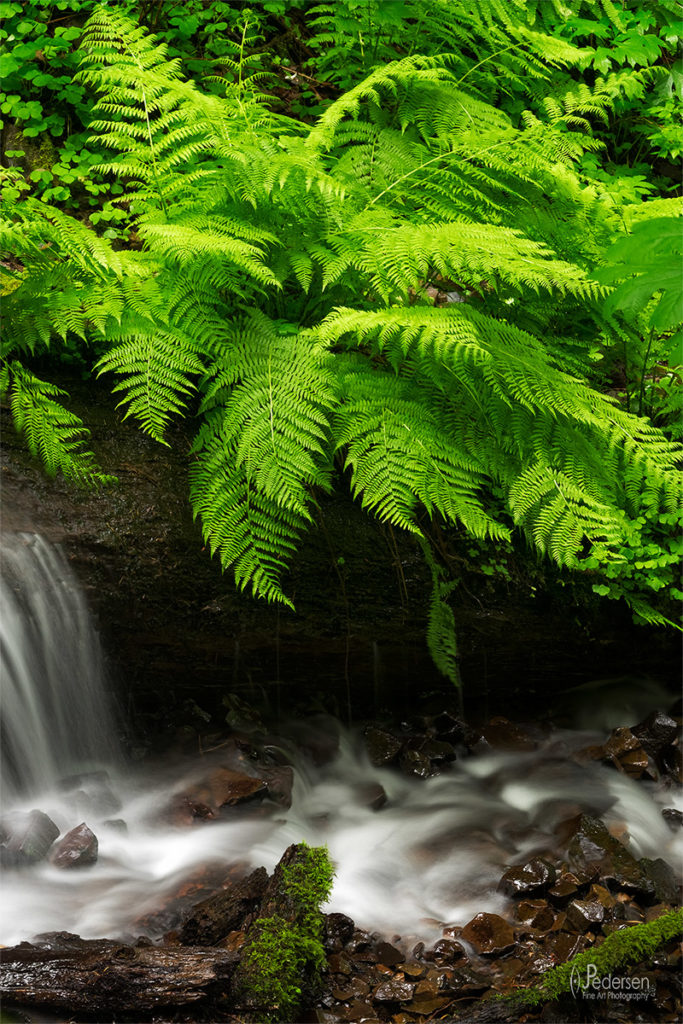
The above image was shot in the Columbia River Gorge. Not 15 yards away was a beautiful waterfall called Fairy Falls. Yes, I shot the waterfall in several different ways, then I moved on to what I really wanted to shoot, the scenes that were calling to me. This is one that is an intimate forest scene showing just a portion of the small stream and focused on the beautiful fern. Looking back after a couple of years, the waterfall shot is another “yea there’s a waterfall” image, yet this one has held on with me, retaining an emotional connection and more intrigue than another waterfall shot. The “feeling” that I tried to capture in this is one of lushness of the forest and the wetness of the area coming together into a encapsulation of what it’s like to hike a trail in the Columbia River Gorge, surrounded by lush greenery and babbling brooks, feeling the forest closing in around you, no other sound than the bubbling of water over the rocks.
Compositional Thoughts
Environment
For sure the scene you are photographing, plus the time of day, plus environmental conditions play a huge roll in the “feeling” of an image. Sunrise, sunset, dark and stormy clouds, brilliant sunshine…contribute the possible feelings you may capture. I talk in this post about photographing fog and how that makes me feel and how I try to convey those feelings in my images. The subject that you are shooting, from grand landscapes to intimate nature scenes, all play a part in how you shoot what it feels like.
Feelings
If you want to shoot what it feels like, the first thing you need to do is give some thought to what your feelings are about being in this location. If you can’t articulate it, you can’t craft the composition to reflect it. You don’t have to come up with a long description of everything you’re feeling, it could be as simple as a word or two; vast, serene, awe-inspiring, jumbled, alone, happy, vibrant, intimate, humbling, warm, cold, forboding…those kinds of words often suffice as a good enough descriptor to start basing a composition around. Identifying and articulating the feelings you want to capture, or highlight, in your image is the first step to shoot how it feels.
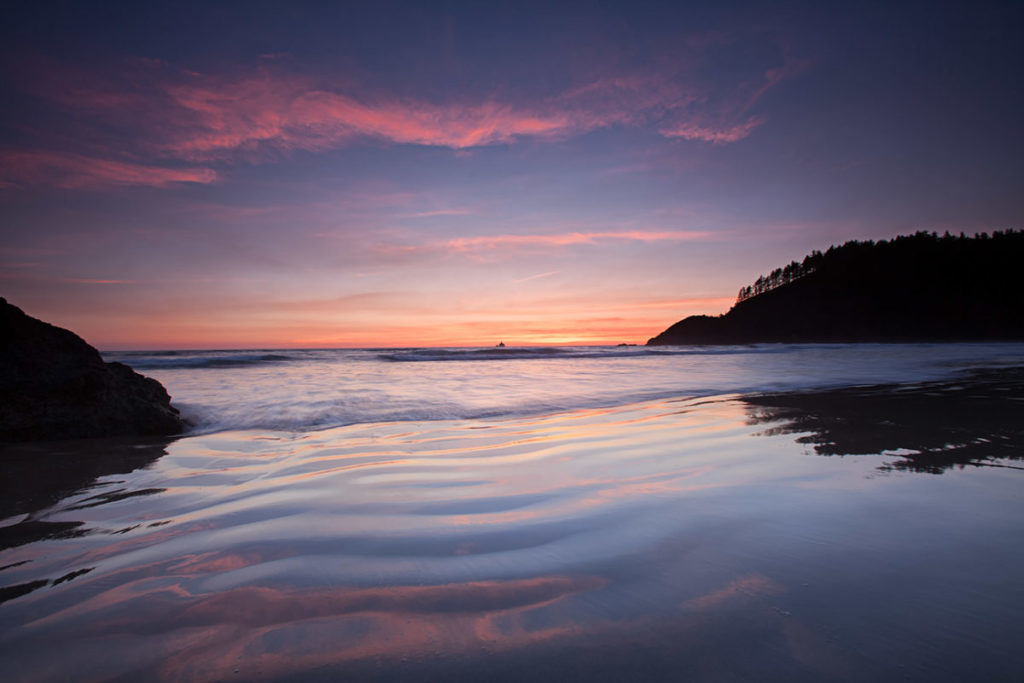
Now, once you’ve identified the feelings you want to convey in your photographs, it’s time to create a composition that will identify and convey that feeling to the viewer.
Color
Typically the feelings we are experiencing on location are close enough to the available building blocks of a composition (color, light, environmental conditions, etc) that we have elements already aligned with the feelings we want to capture. There may be times when you want to capture a particular feeling in a scene, yet the building blocks aren’t readily available to put together a composition; say the color is vibrant and you want to shoot a somber image. In this case you’ll need to work harder to find elements in a scene.
Color is one of the strongest drivers of feeling in an image. Which colors are present in the scene and how they are distributed throughout the composition can have a huge impact on conveying mood and feelings. If you don’t know the psychology of color, I encourage you to read up on it a bit and look at your past images to see if you can draw a correlation between color and feelings. Here is a quick chart showing some of the associations we make with color…
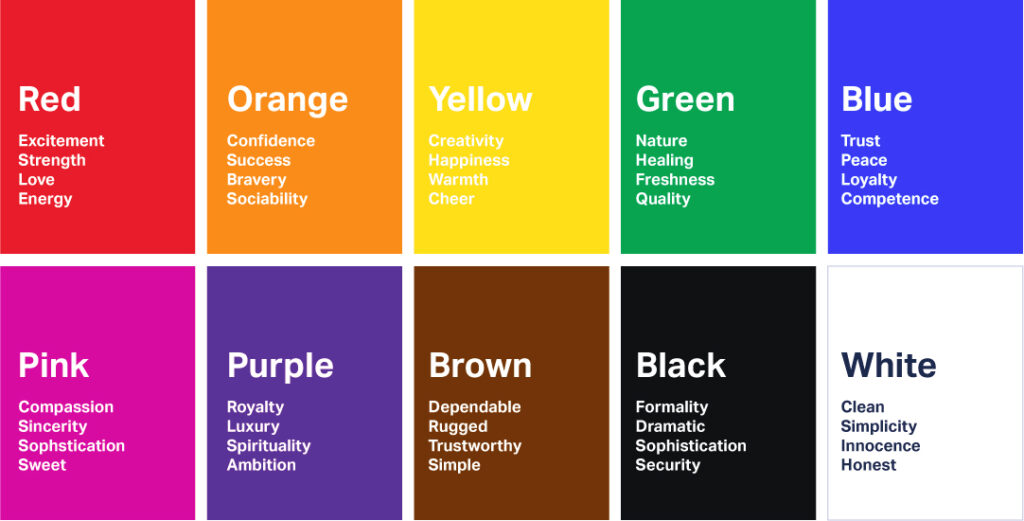
From these descriptive words, we can also draw associations to additional feelings. What I challenge you to do next time you’re in the field is to think about what colors are present in the composition and what feelings are often associated with those colors, then decide if the color theory in your comp matches the feelings that you want to convey in the image. If they match, great, move on to the next step. If they don’t match, then I suggest to re-evaluate the feelings you want to convey versus the scene and determine 1) is there a way you can compose the scene given the colors present to convey the feeling you want or 2) ask yourself if you’re willing to tell a different story based upon the colors.

In this image, as I was composing it, I knew that the majority of the story was the contrasting colors in this shot; light greens, medium greens and the dark blue of the storm clouds in the distance. It was up to me as the artist to determine how much of each color was present in the comp. I could have pointed my camera more downward to include more of the field, or I could have pointed it more upwards to include more of the dark sky.
If I would have included more sky in the shot, the image would have felt “darker” and more somber, plus there wasn’t a lot of definition in the sky to hold visual interest.
So in the end I decided that I wanted more of the really vibrant greens in the foreground to bring some energy, refreshment and nature feeling to an image of a field tended and shaped by man.
Another example of color choices in an image is this shot of Haystack Rock on the Oregon Coast. Of course, I didn’t have a choice as to which colors were present on this particular morning, but I did have a choice as to how much of each color I 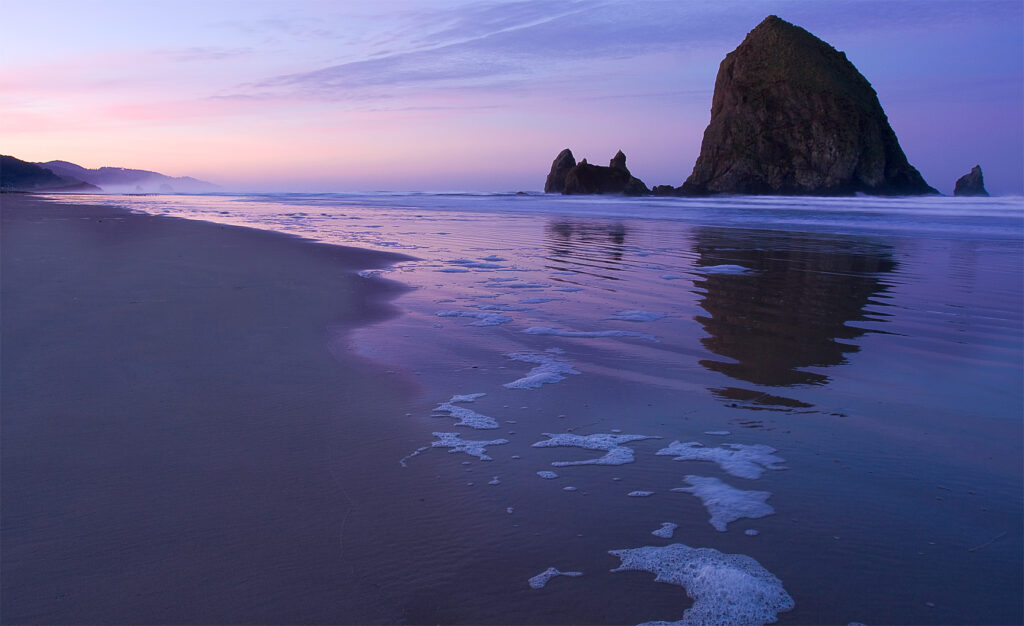 included in my composition to bring the feelings that I wanted to capture. If you evaluate the colors you see blue, violet, pink, yellow, black, and some orange. One question I often ask myself is “what is the dominant/most prevalent color”? In this image, its blue/violet, which from our color chart tells me the words “peace”, “spirituality” and so on. Knowing that, I wanted to convey the stillness of sunrise on the beach, bringing feelings of calm and serenity.
included in my composition to bring the feelings that I wanted to capture. If you evaluate the colors you see blue, violet, pink, yellow, black, and some orange. One question I often ask myself is “what is the dominant/most prevalent color”? In this image, its blue/violet, which from our color chart tells me the words “peace”, “spirituality” and so on. Knowing that, I wanted to convey the stillness of sunrise on the beach, bringing feelings of calm and serenity.
The waves and the ocean usually convey a feeling of energy, strength and sometimes confusion or tumult…which are exactly the feelings I did not want in this image. So as I composed the shot I sought to minimize the importance of the ocean in the composition. I did this by lowering my tripod to reduce the amount of mid-ground in the scene as well as picking a time when the waves were smaller and less pronounced.
And finally, when I got home, one of the things I did in post-processing is to bring out a bit of the yellow in the sand in the foreground. I did this for a couple of reasons…1) to bring some warmth to a largely blue (cold) image 2) yellow is associated with happiness and cheer and I wanted to bring a little more of this to the image and 3) it brings some brighter tones to the image to tie in with the brighter colors in the background.
All of this color theory thinking is done along with the various other thoughts around composition
Balance / Visual Weight / Tension
How we compose a scene has an impact on the feelings that might be conveyed in the image. How objects are dispersed within the comp, their relation to one another, how big or small they are in the overall composition as well as the relation to one another all has an impact on visual perception and thereby the “feelings” of the photograph. One of the goals that I shoot for in many of my images is a feeling of “harmony” amongst the objects I’ve chosen to include in my composition. One of the ways I achieve that is being very critical about what I do include in the comp, oftentimes choosing “less is more”, fewer compositional elements, so that I can then work with a few well-placed objects and move myself around to get the most harmonious feeling possible. When we shoot a scene that has numerous compositional elements, sometimes its very difficult to get them all arranged in a way that is pleasing to the eye. I’ll oftentimes move closer to my main compositional element or I’ll put on a longer focal length lens, both with the goal of narrowing and isolating specifically chosen subjects to include in the photograph.
If you’re not sure what a compositional element is, the simplest way to explain it are those things that are important enough, large enough, or of primary focus in the composition. In the above image of Haystack Rock, the Rock of course is the main element because of it’s relative size in the composition, then the bubbles in the foreground are another specific element, then lastly the clouds and color in the sky are the last main compositional element. It’s how you identify and arrange these elements in your comp that can help you to shoot what it feels like.
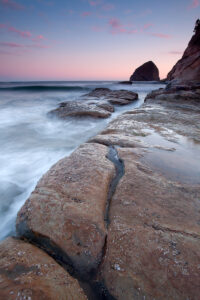
Balance is one of the most obvious topics….if an image “feels balanced”, it means that the main compositional elements are arranged in scene in a way that has an even amount of visual weight across the composition. Or, that the relationship of allof the elements is harmonious in their size, visual weight and positioning in the composition. Balanced images tend to portray feelings of stability, harmony, peace, satisfaction, etc. They are often the most pleasing to viewers. Unbalanced images tend to produce feelings of discomfort, tension, anxiety, or just a general un-settledness. These feelings aren’t bad, no not at all, if that is your intention. There are times when I do intentionally create images that are unbalanced because I want to bring a bit of tension or jarring-aspect to the image. The image to the left was shot intentionally unbalanced as all of the visual weight of the compositional elements are on the right side. If you are intentional about it and that’s obvious to the viewer, then it’s just fine shooting an unbalanced image.
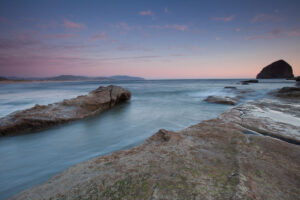
Achieving balance in an image can be easy or hard depending on the elements you have to work with. As an example, here’s a shot from the same location and one that I feel is more balanced. Notice how the different compositional elements arearranged. There is 1) the rock in the foreground 2) the rock in the water off to the left and 3) the haystack in the background. The foreground rocks under the camera are a strong(ish) element in the scene and the color matches that of the rock to the left, which brings some harmony. Because the haystack is almost black, it carries a lot of visual weight, so I chose a focal length and position in the scene that would reduce its physical size in the frame thereby reducing its relative importance and not overpower the two foreground elements. So between these three elements, I feel that I achieved some balance. All I did to achieve these two different “feels” for this scene was slightly adjust my positioning and which elements I chose to include in the frame. Both are good images, its just one has some tension and one has a bit more harmony to it.
Shutter Speed / Technical Details
There are technical aspects you can choose in the camera to help you shoot what it feels like. How motion is captured in our images can have an impact on the “feel” of the image. For example, to portray a high energy moment and capture the feeling of power, grace or aggression, you can use a fast shutter speed to stop the motion and have sharp details throughout the image. 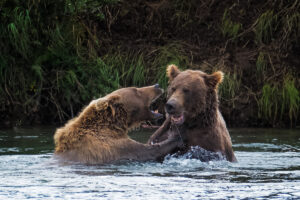 This image of two bears in the river is one where I wanted to capture the energy and excitement of the scene and have the viewer see every last detail that I saw, feel the fury of the bears, get a sense of their power and the dynamics of the scene. If I would have had a slower shutter speed, there would have been more blur in the image of course, but also that “softer” image wouldn’t have conveyed the power and energy as much as a faster shutter speed.
This image of two bears in the river is one where I wanted to capture the energy and excitement of the scene and have the viewer see every last detail that I saw, feel the fury of the bears, get a sense of their power and the dynamics of the scene. If I would have had a slower shutter speed, there would have been more blur in the image of course, but also that “softer” image wouldn’t have conveyed the power and energy as much as a faster shutter speed.
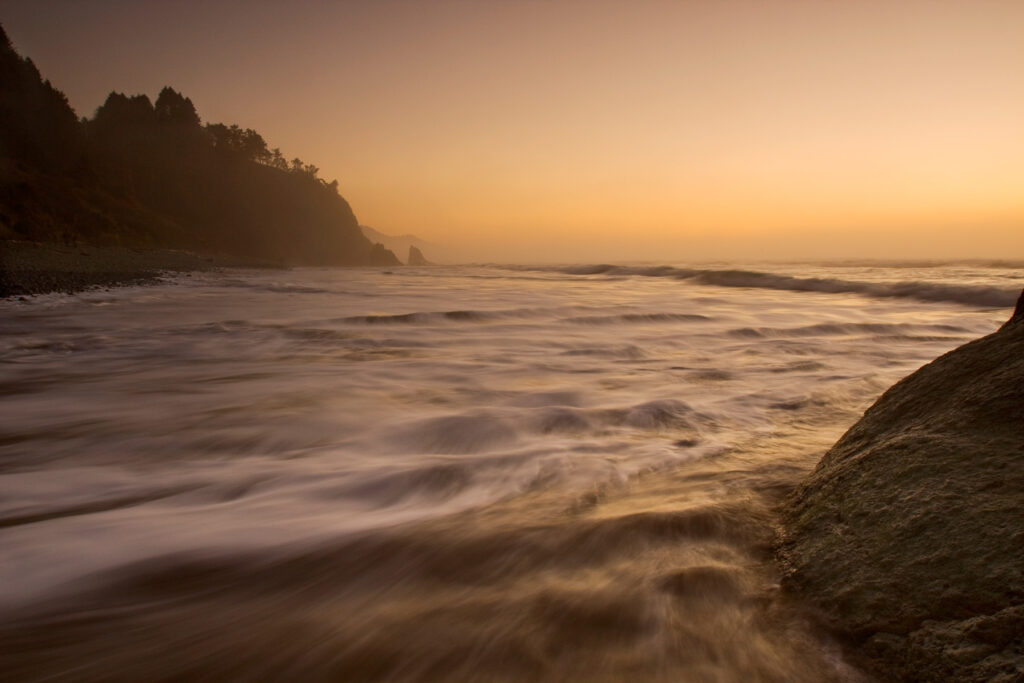
Conversely, using a slower shutter speed can bring more calm and serene feels to an image. Photographing water is a great example of this. If you are shooting the ocean, you can choose to use a fast shutter speed and “stop” the waves, preserving every detail, which I feel brings power and energy to the image. On the other side of the spectrum is using a longer shutter speed to smooth out the waves so there is less “energy” depicted as well as the softness of the waves brings calmer feelings to the image.
While I’m on the subject of photographing the ocean and shutter speeds, I want to touch on the nuance of blurring the water to change the feeling in an image. You can control the amount of blur in the water to change the feel, going from energetic blur to dream-state blur and both will have an impact on how the image feels. So, when you’re shooting what it feels like, assess for yourself whether your feelings are “energetic” or “serene” and use the shutter speed most appropriate. I can’t tell you what the “right” shutter speed is….you are the artist and it’s your choice. Plus, a lot depends on the volume of water and the speed that its moving, which will dictate the appropriate shutter speed for the mood you want to capture. Here are a couple of examples to illustrate my point. Both of these images were shot in Bandon Oregon, one at sunset and one at sunrise. Notice the water…
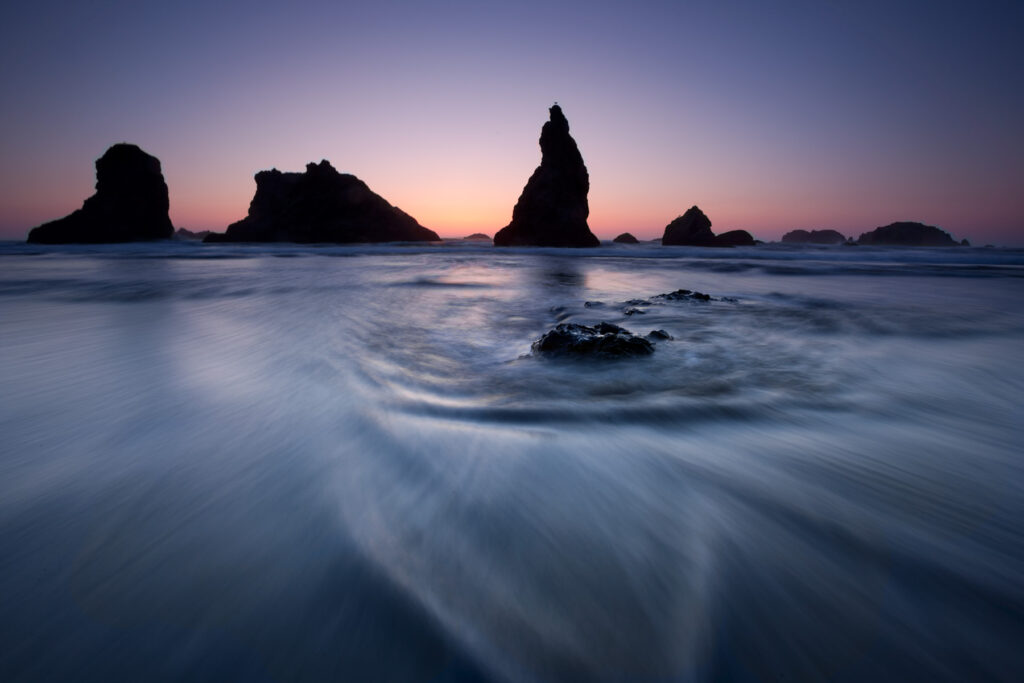
f/18, 1/6 sec., iso 100
In the above image, the water is smooth with gentle flowing lines. I captured the sense, or feeling, of movement, yet it is subdued and not a dominant element in the image. I wanted to create a calm and reflective image since that is how I was feeling at the time after a long day. Quietness, serenity, etc., are what I was going for. Plus, having the rocks silhouetted contributes to the calm since there is not a lot of visual information to process, just their outlines.
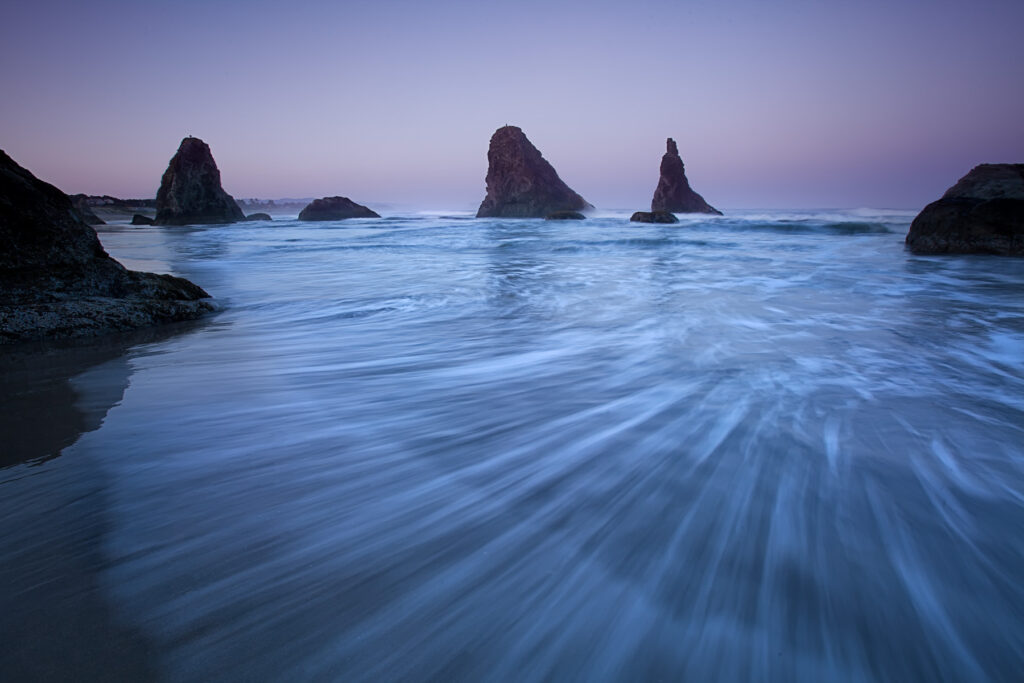
f/14, 1 sec., iso 100
In this image, I sped up my shutter speed to capture the speed and dynamic action of the ocean and it is an important element in this composition. I feel that the more pronounced streaks of sea foam bring a sense of energy to the image, which is what I was feeling when I shot this. It was the start of a beautiful day and I was excited to be at this location, so I chose to capture more “energy” in this shot to reflect what I was feeling.
Post-Processing
As much as I strive to shoot what it feels like and capture it in camera, there are times when I can accentuate feelings in post processing if the camera (or I) didn’t record the image quite as I felt it. I can alter the feeling of the image using the tools to change the color, light and visual balance in the image. I won’t dive too deep in to this area, I just hope to give you some thoughts to think about when you are processing your own images.
Color
As mentioned above, color and color temperature can have a profound impact on how an image feels. Speaking of color temperature, if you are shooting in RAW, you can adjust the white balance of the image to bring more coolness or warmth to the image. You can’t do this in jpeg, which is why I shoot in both RAW and jpeg, in case I have a need to adjust my WB in post (you can also adjust in camera for each scene you shoot). Then, you can further work on the colors in an image, accentuating or de-accentuating certain colors to bring about the feeling that you felt when you captured the image. There are a myriad of ways to do this, use whatever suits you best, just don’t be too obvious in your adjustments. Building up several subtle adjustments is always much better than making one big adjustment.
Light
You can shape and sculpt the light in post-processing to highlight or de-emphasize certain portions or elements in your images, which will help to bring about the “feel” that you are wanting to capture in the image.
Visual Balance
Again, I’m a proponent of getting it as right as possible in the field but sometimes there may be a need to adjust the “balance” of the image with a small crop in order to position the important elements “just so” in the image to bring about the feel you are wanting. Is one element further away from the edge than the others and if so, does it “feel” right or could there be more balance of the elements in relation to the edges of the image.
Conclusion
“Don’t shoot what it looks like, shoot what it feels like.” It seems simple enough on the surface, but is in fact much harder in practice. Too often we are wrapped up in the excitement of being at a location or being with friends. Or, we are so focused on the technical aspects of our cameras or the act of photographing, that we don’t slow down and connect to our surroundings and consciously connect our feelings and then work to create a composition that reflects what it feels like to be in this location at this particular time. Next time you are out, try to practice this simple, yet challenging concept of shooting what it feels like.
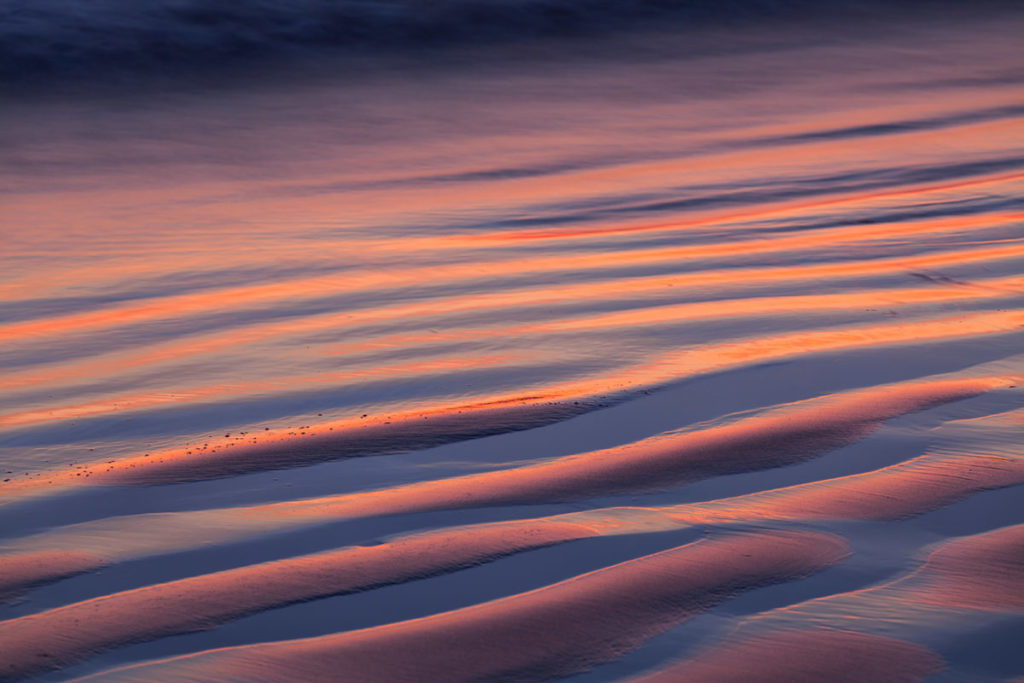

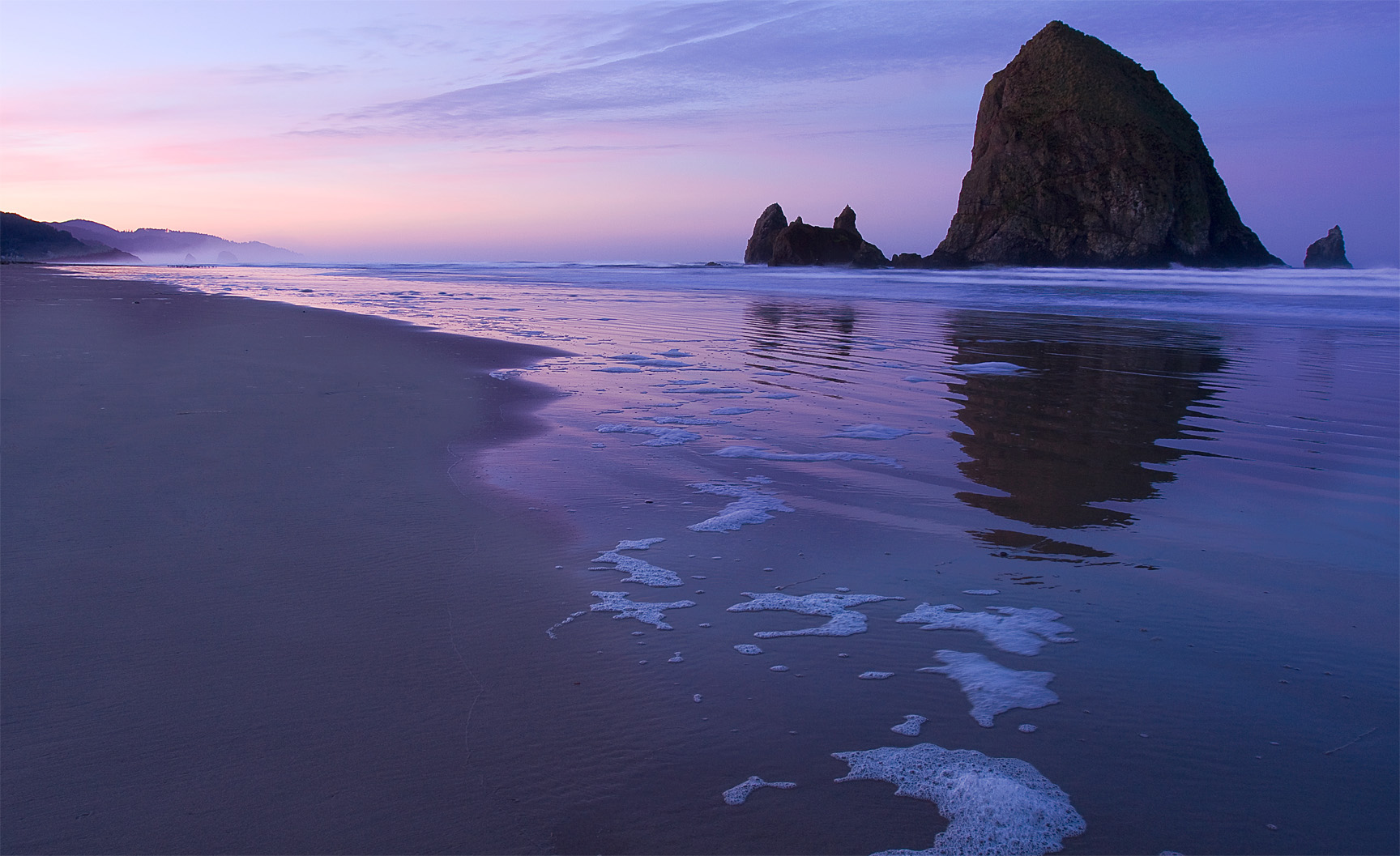
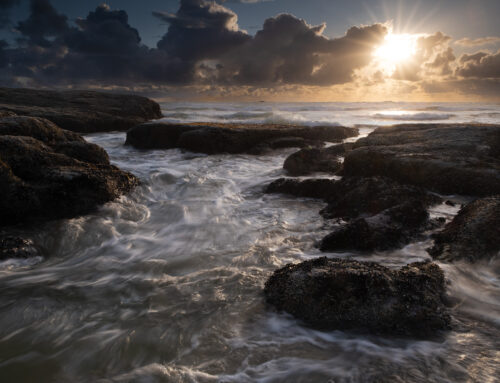
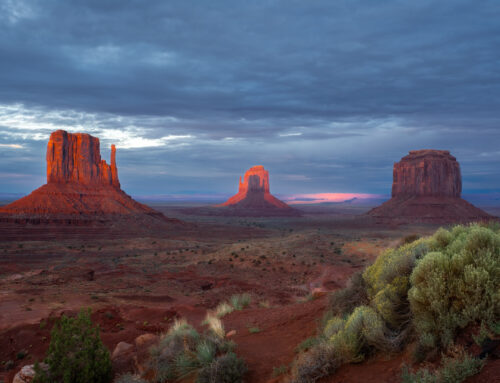
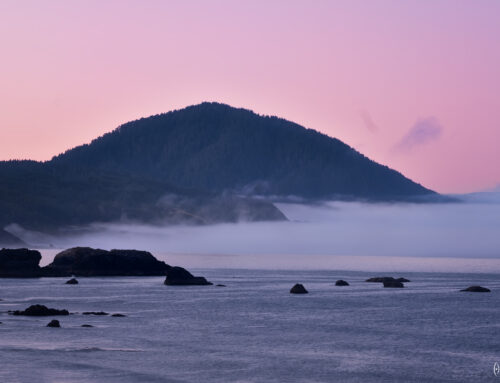
Leave A Comment